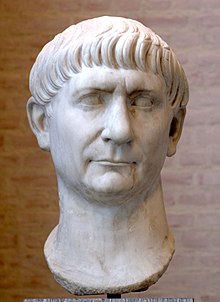From Wikipedia, the free encyclopedia
"Traian" redirects here. For other uses, see Traian (disambiguation).
| Trajan | |||||
|---|---|---|---|---|---|

Marble bust of Trajan
|
|||||
| 13th Emperor of the Roman Empire | |||||
| Reign | 27 January 98 – 8 August 117 | ||||
| Predecessor | Nerva, adoptive father | ||||
| Successor | Hadrian | ||||
| Born | 18 September 53 Italica, Hispania, now Province of Seville, Andalusia, Spain |
||||
| Died | 8 August 117 (aged 63) Selinus, Cilicia, now Gazipaşa, Antalya Province, Turkey |
||||
| Burial | Rome (ashes in foot of Trajan's Column, now lost), now Trajan's Forum, Rome, Italy |
||||
| Wife | |||||
|
|||||
| Dynasty | Nerva–Antonine | ||||
| Father |
|
||||
| Mother | Marcia | ||||
|
||||||||||||||
Born in the city of Italica in the province of Hispania Baetica, Trajan's non-patrician family was of Italian and perhaps Iberian origin. Trajan rose to prominence during the reign of emperor Domitian. Serving as a legatus legionis in Hispania Tarraconensis, in 89 Trajan supported Domitian against a revolt on the Rhine led by Antonius Saturninus. In September 96, Domitian was succeeded by Marcus Cocceius Nerva, an old and childless senator who proved to be unpopular with the army. After a brief and tumultuous year in power, culminating in a revolt by members of the Praetorian Guard, Nerva was compelled to adopt the more popular Trajan as his heir and successor. He died on 27 January 98 and was succeeded by his adopted son without incident.
As a civilian administrator, Trajan is best known for his extensive public building program, which reshaped the city of Rome and left numerous enduring landmarks such as Trajan's Forum, Trajan's Market and Trajan's Column. Early in his reign, he annexed the Nabataean Kingdom, creating the province of Arabia Petraea. His conquest of Dacia enriched the empire greatly, as the new province possessed many valuable gold mines. However, its exposed position north of the Danube made it susceptible to attack on three sides, and it was later abandoned by Emperor Aurelian.
Trajan's war against the Parthian Empire ended with the sack of the capital Ctesiphon and the annexation of Armenia and Mesopotamia. His campaigns expanded the Roman Empire to its greatest territorial extent. In late 117, while sailing back to Rome, Trajan fell ill and died of a stroke in the city of Selinus. He was deified by the Senate and his ashes were laid to rest under Trajan's Column. He was succeeded by his adopted son Hadrian.
No comments:
Post a Comment